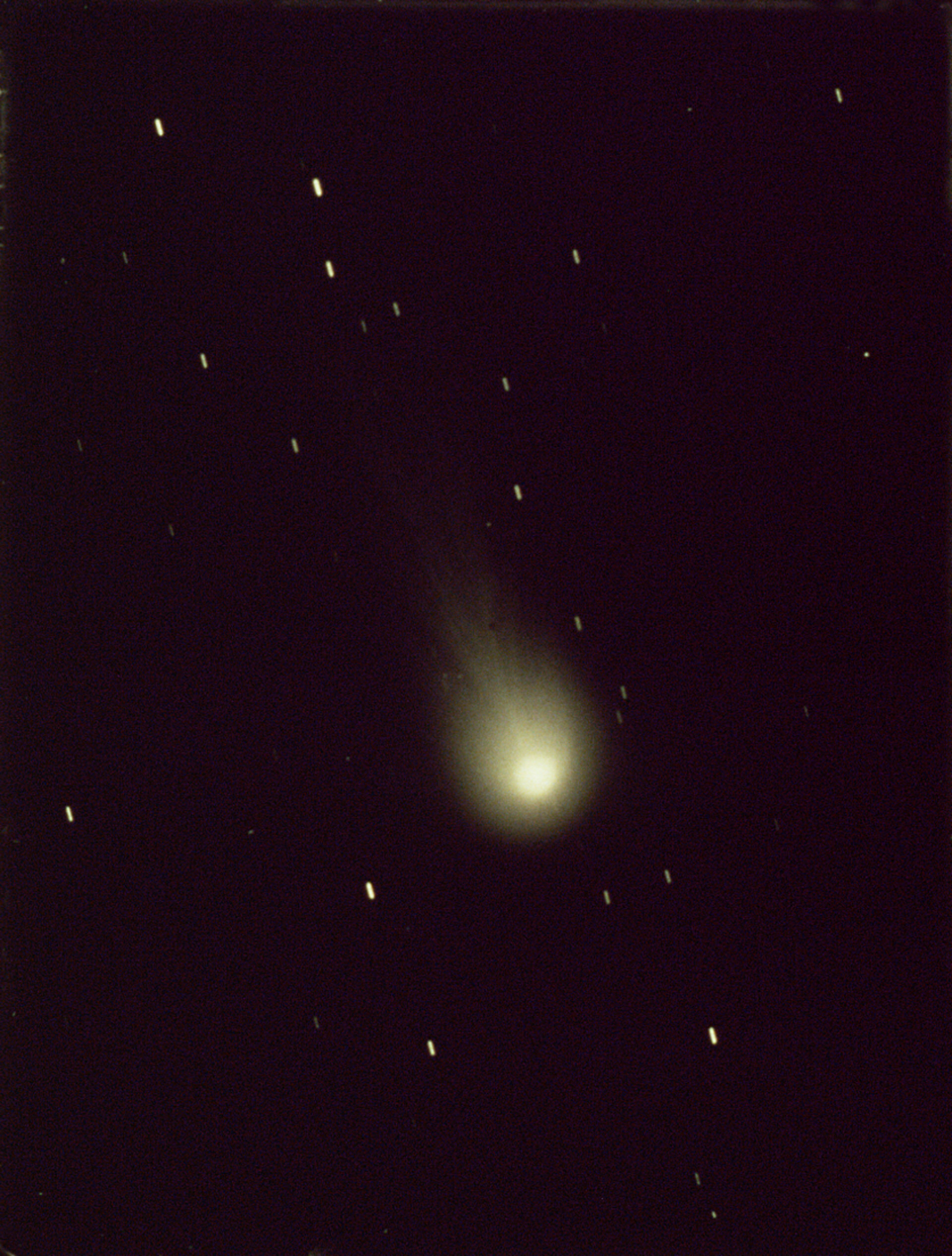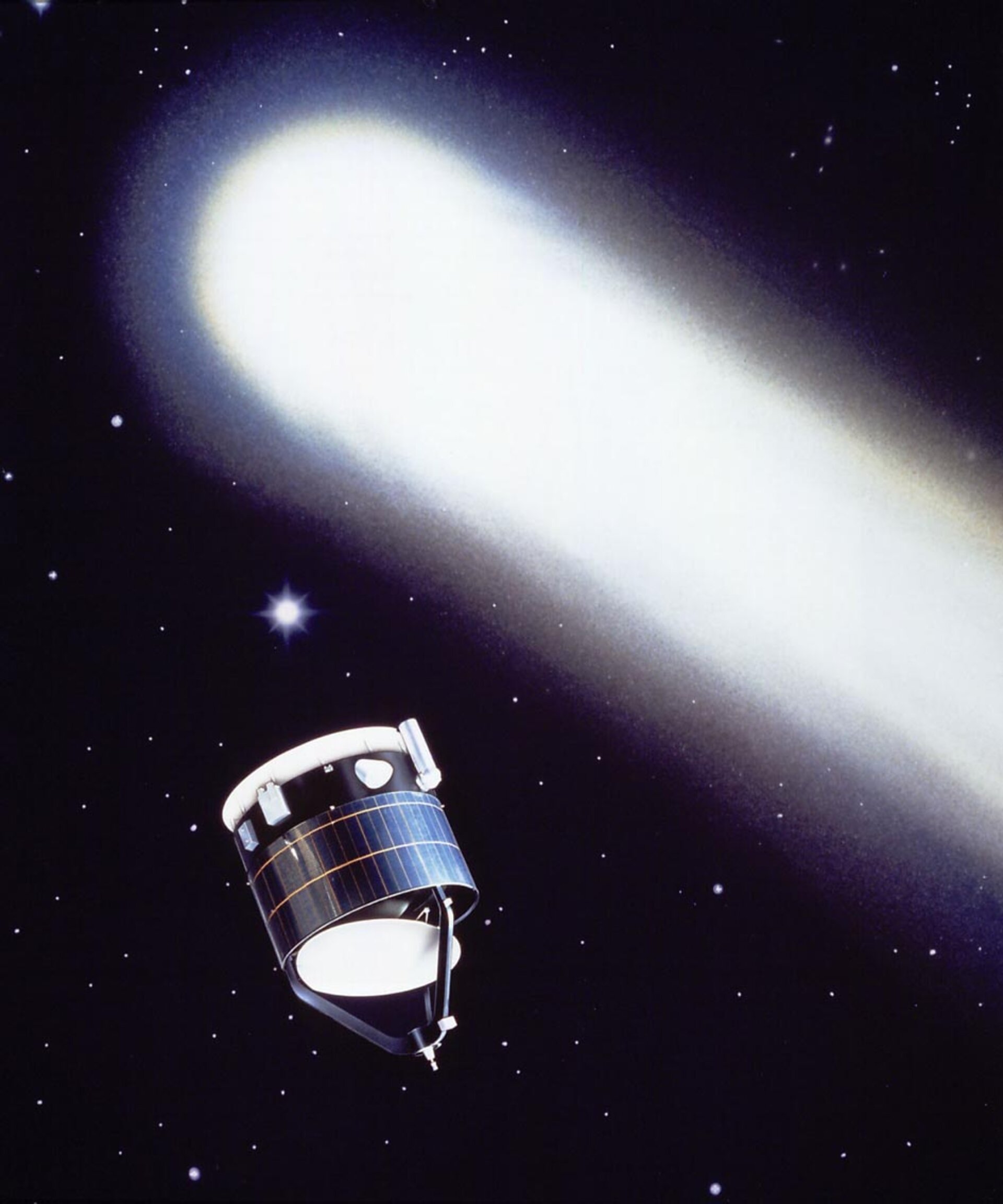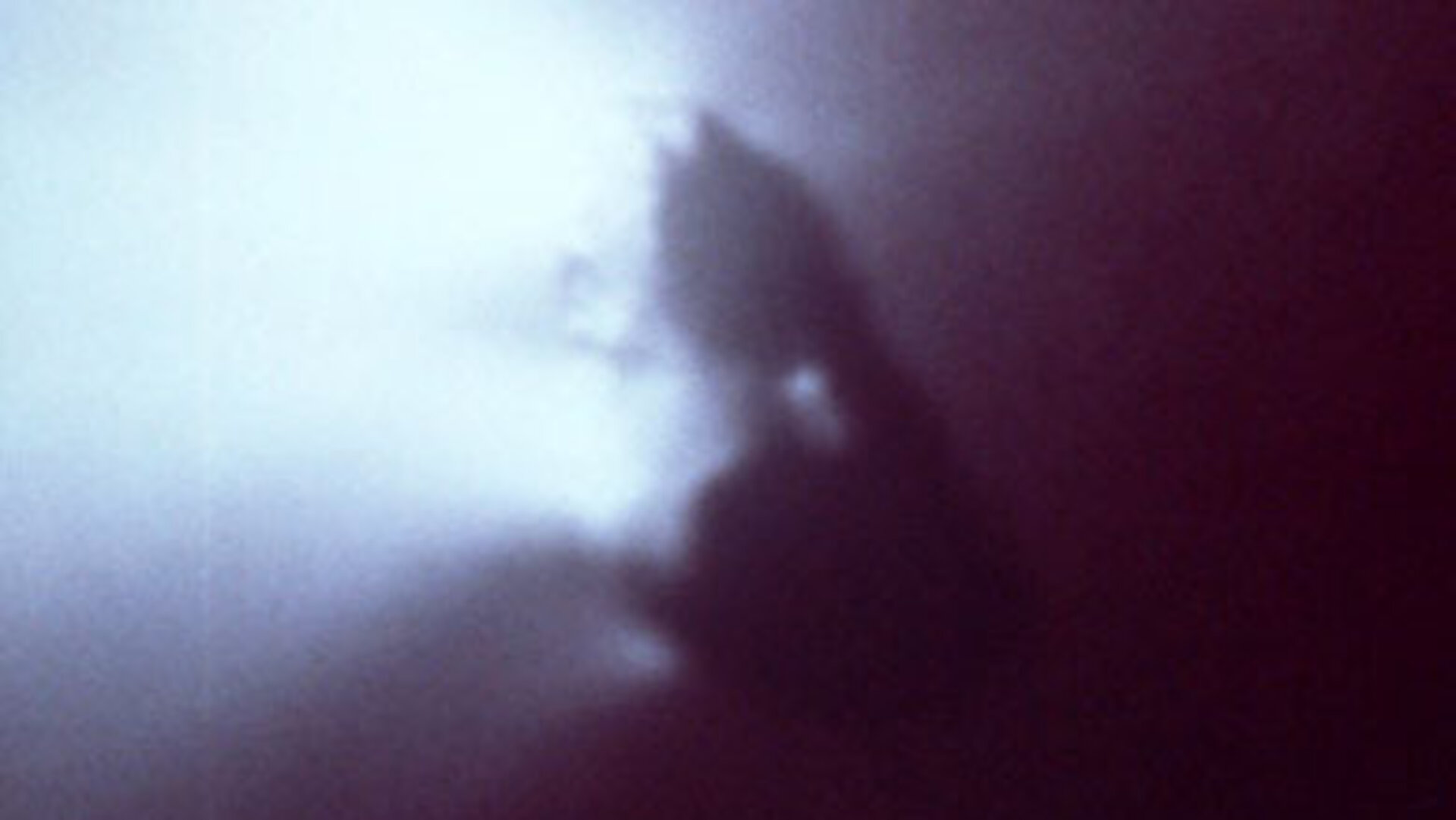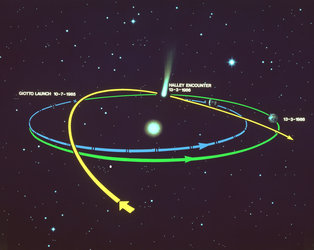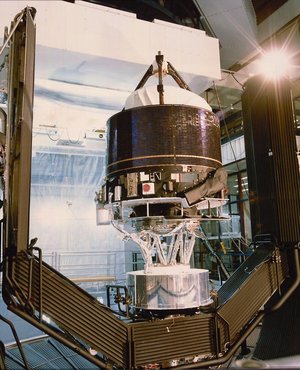Giotto overview
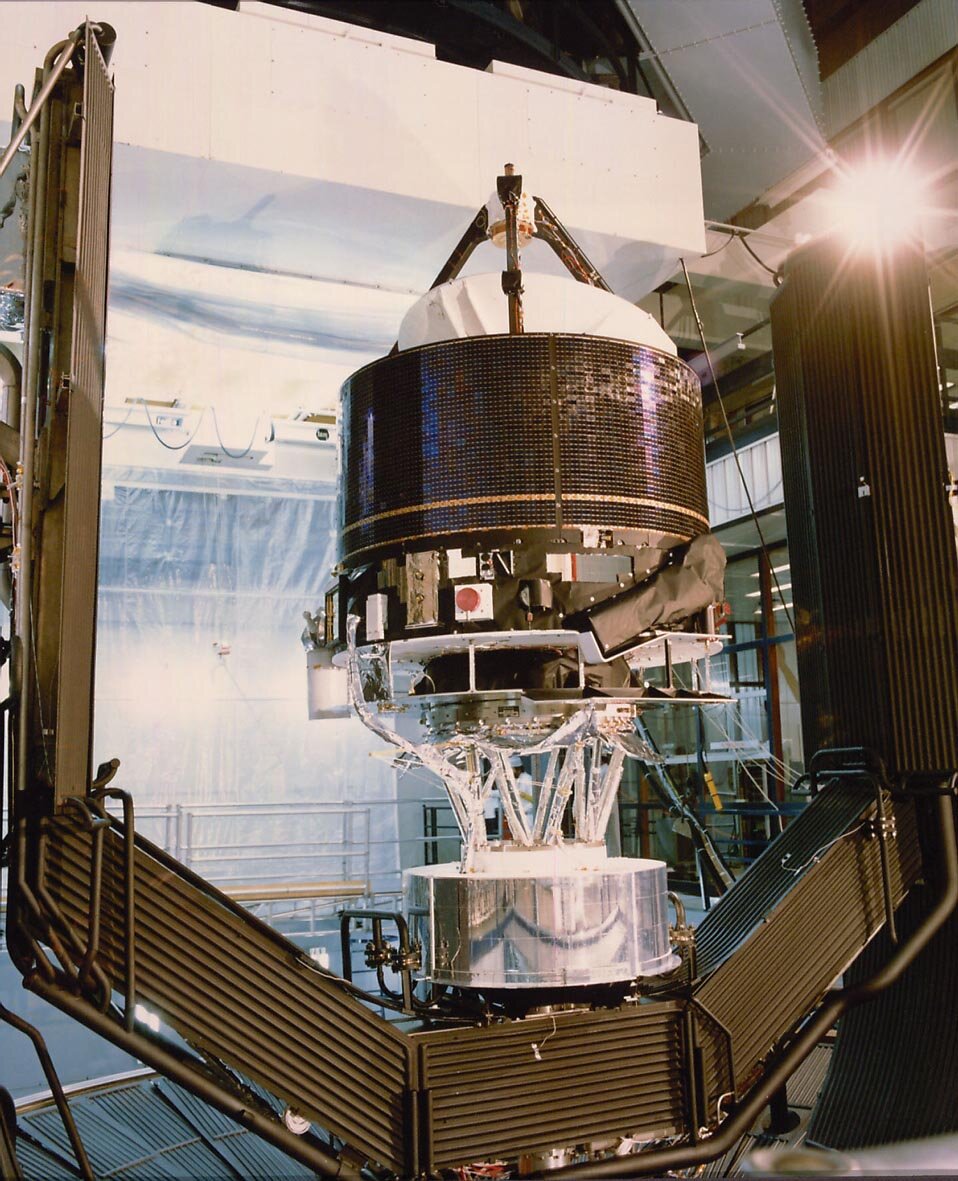
Name: Giotto, after Italian painter Giotto di Bondone who observed Halley's Comet in 1301 and depicted it as the star of Bethlehem in his painting Adoration of the Magi in the Scrovegni Chapel
Launched: 2 July 1985
Status: Completed (1992)
Objective
Making encounters with comets Halley and Grigg–Skjellerup, Giotto was ESA’s first deep-space mission. It imaged a comet nucleus for the first time and found the first evidence of organic material on a comet.
Mission
Giotto was ESA’s first deep-space mission. In 1986, it passed closest to the nucleus of a comet, Halley. Its images showed for the first time the shape of a comet nucleus and found the first evidence of organic material in a comet.
In 1992, after a long cruise through space, Giotto was directed to Comet Grigg–Skjellerup. It sent back a lot of information, passing just 200 kilometres from the nucleus.
What’s special?
Giotto had a number of very impressive ‘firsts’ and achievements to its credit:
It was Europe's first deep-space mission.
It photographed the first close-up images of a comet nucleus (Halley). It discovered the size and shape of Halley's nucleus and discovered that the surface is very dark and that bright jets of gas and dust spring out of its nucleus.
It was the first deep-space mission to change orbit by returning to Earth for a gravity-assist manoeuvre.
Giotto made the closest comet flyby to date by any spacecraft (about 200 kilometres from Comet Grigg–Skjellerup) and studied the interaction between the solar wind, the interplanetary magnetic field, and the comet itself.
It was the first spacecraft to encounter two comets and in doing so measured the size, composition, and velocity of dust particles and measured the composition of those two comets.
Spacecraft
Giotto was based on the GEOS Earth-orbiting research satellites, which were built by British Aerospace at Bristol, United Kingdom. The most significant modification was the addition of a shield to protect it from a battering by high-speed dust particles during the comet encounter.
By spacecraft standards, the 960-kilogram Giotto was small in size. Its main body was a short cylinder about 2 metres in diameter by about 1 metre in height. It contained three interior platforms: the top platform, a main platform, and an experiment platform. Each of these consisted of a disc within the cylinder on which were mounted various subsystems and science experiments. On top of the cylinder was a 1.5-metre diameter high-gain dish antenna and gave the spacecraft a total height of about 3 metres. The main rocket motor was positioned in the centre of the cylinder with the nozzle protruding from the bottom.
The most difficult problem to overcome was how to ensure that Giotto survived long enough to snap its close-up pictures of the nucleus when the spacecraft and the comet were heading towards each other at a combined speed of 245 000 kilometres per hour (equivalent to crossing the Atlantic Ocean in 11 minutes!). At this speed, a 0.1 gram dust particle would be able to penetrate 8 centimetres of solid aluminium. Since it was out of the question to equip Giotto with a 600-kilogram aluminium shield, engineers turned to a more subtle, sandwich design first proposed by American astronomer Fred Whipple back in 1947 – long before the beginning of the Space Age.
The spacecraft's dust shield consisted of two protective sheets, 23 centimetres apart. At the front was a sheet of aluminium (1 millimetre thick), which would vaporise all but the largest of the incoming dust particles. A 12-milimetre thick sheet of Kevlar at the rear would absorb any debris that pierced the front barrier. Together they could withstand impacts from particles up to 1 gram in mass and travelling 50 times faster than a bullet.
Electrical power came from a solar array made of about 5000 silicon cells wrapped around Giotto’s cylindrical exterior. These provided 190 Watts of power during the first comet encounter. Four silver-cadmium batteries were carried as back up and for use when the spacecraft was in shadow.
The spacecraft was spin-stabilised as it rotated at 15 revolutions per minute. During the encounter with Halley’s Comet, the spacecraft approached with its dust shield and spin axis pointing towards the nucleus. Its dish antenna continually pointed at the Earth to ensure non-stop communications.
Journey
Giotto was initially injected into a geostationary transfer orbit. After three revolutions around the Earth, the on-board motor was fired to inject into an interplanetary orbit. After a cruise phase of 8 months, Giotto encountered Comet Halley on 14 March 1986. For its (initially unscheduled) visit to the second comet, Grigg–Skjellerup, Giotto was flown back to the direction of Earth for a gravity-assist to reach its new target.
To add more detail, the adventure began with Giotto almost 150 million kilometres from Earth. On 12 March 1986, the spacecraft's instruments first detected hydrogen ions 7.8 million kilometres from Comet Halley. 22 hours later, Giotto crossed the bow shock of the solar wind (the region where a shock wave is created as the supersonic solar particles slow to subsonic speed) and entered the densest part of the dusty coma. At this point, the camera was switched to tracking mode to follow the brightest object (the comet nucleus) in its field of view and began to send the first, fuzzy images back to Earth.
Excitement rose at the European Space Operations Centre in Darmstadt, Germany, as the stream of pictures and data came in. Located in adjacent rooms, each of the ten experiment teams scrutinised the latest information and struggled to come up with a preliminary analysis.
The first of 12 000 dust impacts were recorded 122 minutes before closest approach. Images were transmitted as Giotto closed in to within a distance of 1372 kilometres, but the rate of dust impacts rose sharply as the spacecraft passed through a jet of material that streamed away from the nucleus. At that time the spacecraft was travelling at a speed of 68 kilometres a second relative to the nucleus of Halley. Only 7.6 seconds before closest approach, the spacecraft was sent spinning by an impact from a ‘large’ (one gram) particle. Monitor screens went blank as contact with the Earth was temporarily lost. TV audiences and anxious Giotto team members feared the worst, but, to everyone’s amazement, occasional bursts of information began to come through. Giotto was still alive. Over the next 32 minutes, the sturdy spacecraft's thrusters stabilised its motion and contact was fully restored. By then Giotto had passed within 596 kilometres of the nucleus and was heading back into interplanetary space.
The remarkably resilient little spacecraft continued to return scientific data for another 24 hours on the outward journey. The last dust impact was detected 49 minutes after closest approach. The historic encounter ended 15 March when Giotto’s experiments were turned off.
However, the spacecraft still had 60 kilograms of fuel available, so the option was open to continue Giotto’s voyage of exploration. A series of three small orbital corrections ensured that it would return to Earth almost exactly five years after launch. On 2 April 1986, the spacecraft was placed into hibernation in the hope that it could be successfully revived and dispatched on another mission. 1419 days later, in February 1990, the signal was sent to reawaken Giotto. After such a long period without contact, controllers had no idea whether the harsh environment of space had damaged its systems. Another unknown was the direction in which the main antenna was pointing. The only hope was that an omni-directional low-gain antenna would detect the wake-up signal. Two hours later, a weak answer from Giotto was received at the NASA Deep Space Network ground station near Madrid, Spain. Within a week, full control was regained and the ESA team was able to assess its condition. Three science instruments proved fully operational, while four more were partially damaged but usable. Although the remaining three instruments, including the camera, were disabled, it was decided to redirect the spacecraft towards a second comet.
On 2 July 1990, Giotto's orbit was altered as it flew past the Earth, just 22 730 kilometres above the cloud tops. This was the first time a spacecraft coming from deep space had used the Earth for a gravity-assist. During the flyby, observations were made of the Earth’s magnetic field and energetic particle environment.
After another prolonged hibernation, Giotto's payload was switched on in the evening of 9 July 1992. The Grigg–Skjellerup flyby took place the following day, about 215 million kilometres from Earth. Giotto crossed the bow shock and entered the dust coma about 17 000 kilometres from the comet. Aimed directly at the nucleus, Giotto missed by a mere 100 to 200 kilometres – the closest ever cometary flyby.
History
Giotto was originally put forward as part of a joint NASA/ESA comet mission, but at a later stage the United States pulled out. Then ESA took the bold decision to proceed alone on this once-in-a-lifetime venture. There was little leeway for delays if this flyby opportunity was missed, Halley's Comet would disappear into the depths of the Solar System, to be hidden from view for the next 75 years!
Giotto was ESA's first deep space mission, part of an ambitious international effort to solve the mysteries surrounding Comet Halley. The plan was to send an armada of five space probes – two Soviet, two Japanese and one European – towards the comet on its return to the inner Solar System in 1986. While the Japanese spacecraft made long distance measurements, the Soviet Vegas would act as pathfinders, passing close enough to locate the comet's nucleus. The information they sent back would allow Giotto to home in with great accuracy on Halley's solid heart.
After the mission was given the go-ahead by ESA in 1980, it was put together very quickly. Originally envisaged as part of a dual launch by a powerful Ariane 3 rocket, it was eventually launched by an Ariane 1 rocket (flight V14) on 2 July 1985.
Partnerships
The following organisations built the various scientific instruments on board Giotto: University of Cologne (Germany), MPI (Lindau, Germany), University of Kent (Canterbury, United Kingdom), CESR (Toulouse, France), Mullard Space Science Laboratory (Holmbury St Mary, United Kingdom), MPI (Heidelberg, Germany), CNRS (Verrières-le-Buisson, France), St. Patrick's College (Maynooth, Ireland), University of Bern (Switzerland) and the Ruhr University (Bochum, Germany).















 Germany
Germany
 Austria
Austria
 Belgium
Belgium
 Denmark
Denmark
 Spain
Spain
 Estonia
Estonia
 Finland
Finland
 France
France
 Greece
Greece
 Hungary
Hungary
 Ireland
Ireland
 Italy
Italy
 Luxembourg
Luxembourg
 Norway
Norway
 The Netherlands
The Netherlands
 Poland
Poland
 Portugal
Portugal
 Czechia
Czechia
 Romania
Romania
 United Kingdom
United Kingdom
 Slovenia
Slovenia
 Sweden
Sweden
 Switzerland
Switzerland


























